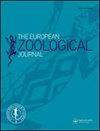贝加尔湖沿岸地区表生蛭形轮虫的多样性有限,与高度多样的地方性片脚类没有共同多样性模式
IF 1.4
4区 生物学
Q2 ZOOLOGY
引用次数: 0
摘要
摘要俄罗斯西伯利亚贝加尔湖发生了数百种不同动物群的极端辐射;其中,片脚类是无脊椎动物中最引人注目的类群之一,约有350种特有物种。两栖类寄主相关的表生轮虫,本研究的目的是探索贝加尔湖两栖类轮虫作为表生体与寄主共同进化并通过物种特异性寄主-表生体联合而多样化的可能性。我们对16个物种的148个片脚类个体进行了采样,并从中分离出了所有表生蛭类,发现只有一个蛭类物种Embata parasitica与属于三个不同科的至少六个片脚目物种有关联。与大多数其他蛭类物种的已知情况类似,贝加尔湖的形态物种Embata parasitica很可能是一个神秘物种的复合体,正如我们在几种动物的一个线粒体标记中发现的高度遗传多样性所表明的那样。然而,没有一个不同的遗传谱系似乎只与一个或几个两栖类物种有关。此外,在湖中发现了9种蛭类物种,使该地区的已知多样性增加到12种。本文章由计算机程序翻译,如有差异,请以英文原文为准。
Limited diversity of epibiont bdelloid rotifers and no pattern of codiversification with the highly diverse endemic amphipods of a coastal zone of Lake Baikal
Abstract An extreme radiation of hundreds of species of different groups of animals occurred in Lake Baikal, Siberia, Russia; among them, amphipods represent one of the most remarkable groups of invertebrates with about 350 endemic species. Amphipods host associated epibiont rotifers, and the aim of the study is to explore the possibility that bdelloid rotifers living as epibionts on amphipods in Lake Baikal coevolved with their hosts and diversified with species-specific host–epibiont associations. We sampled 148 individual amphipods belonging to 16 species and isolated all epibiont bdelloids from them, discovering that only one bdelloid species, Embata parasitica, lives associated with at least six amphipod species belonging to three different families. Similar to what is known in most other bdelloid species, the morphospecies Embata parasitica from Lake Baikal is likely to be a complex of cryptic species, as suggested by the high genetic diversity we found in one mitochondrial marker sequenced from several animals. Yet none of the divergent genetic lineages seemed to be associated to only one or a few amphipod species. In addition, nine bdelloid species were found living in the lake, increasing the known diversity of the area to 12 bdelloid species.
求助全文
通过发布文献求助,成功后即可免费获取论文全文。
去求助
来源期刊

European Zoological Journal
Agricultural and Biological Sciences-Animal Science and Zoology
CiteScore
3.10
自引率
5.60%
发文量
80
审稿时长
30 weeks
期刊介绍:
The European Zoological Journal (previously Italian Journal of Zoology) is an open access journal devoted to the study of all aspects of basic, comparative and applied protozoan and animal biology at molecular, cellular, tissue, organ, organismal, population, and community-ecosystem level. Papers covering multiple levels of organization and integrative approaches to study animal form, function, development, ecology, evolution and systematics are welcome. First established in 1930 under the name of Il Bollettino di Zoologia, the journal now has an international focus, reflected through its global editorial board, and wide author and readership.
 求助内容:
求助内容: 应助结果提醒方式:
应助结果提醒方式:


